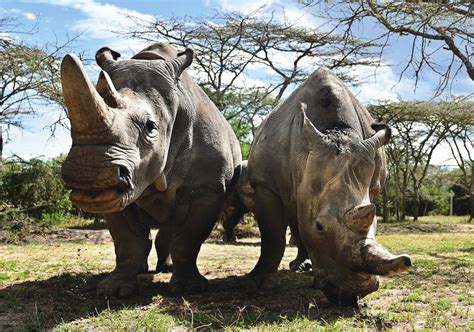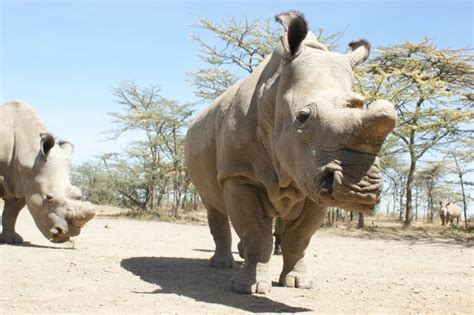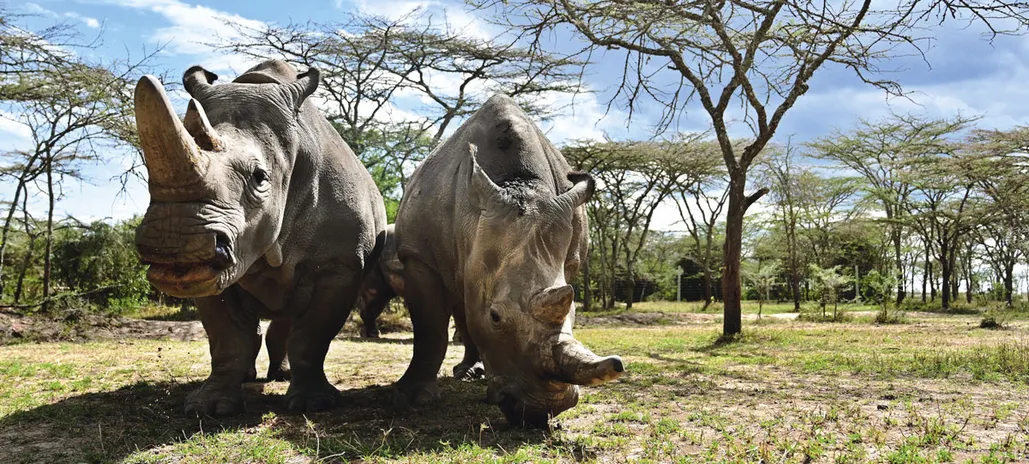The white rhino, one of the planet’s most iconic and majestic creatures, is teetering on the brink of extinction. With their numbers dwindling due to relentless poaching and habitat loss, the urgency to protect and preserve these magnificent animals has never been greater. This article delves into the critical conservation efforts aimed at saving the white rhino from extinction. We will explore the challenges faced by conservationists, the vital role of governments and NGOs, the innovative technologies being deployed, and how communities around the world can contribute to this fight. Together, these efforts offer hope for the future of the white rhino.
ugodj.com offers a detailed exploration of this topic.
1. Why the White Rhino is Endangered
The white rhinoceros faces a grave threat, primarily due to two major factors: poaching and habitat loss. Poaching is driven by the insatiable demand for rhino horns, which are falsely believed to possess medicinal properties and are highly prized in some cultures as a symbol of status. This illegal trade has drastically reduced white rhino populations, as poachers employ increasingly sophisticated methods to hunt them.
The plight of the white rhino is further aggravated by habitat loss. As human settlements, agriculture, and infrastructure development expand, they encroach on the white rhino’s natural habitats. This encroachment leads to fragmentation of their living spaces, making it challenging for them to find adequate food, water, and secure breeding grounds. This combination of factors has pushed the white rhino to the brink of extinction, making it one of the most endangered species globally. Urgent and sustained conservation efforts are imperative to ensure the white rhino’s survival. Without these efforts, the species faces a grave threat of disappearing forever.

2. Why Conservation Efforts are Crucial
The white rhino’s survival hinges on conservation efforts, as this species plays a vital role in the ecological equilibrium of its habitat. As mega-herbivores, white rhinos shape the landscape by grazing on grasses, supporting a diverse array of other species, including small mammals, birds, and insects. The absence of white rhinos would disrupt these ecosystems, triggering a cascade of biodiversity loss.
The white rhino is more than just a vital part of its ecosystem; it represents a broader struggle for conservation. Protecting it demands confronting complex issues like poaching, illegal wildlife trade, and habitat loss—challenges that impact countless other species. Therefore, by prioritizing the white rhino’s survival, we simultaneously safeguard a wider array of wildlife and their natural habitats.
White rhinos have profound cultural and economic significance, especially in areas reliant on wildlife tourism. Their presence draws tourists, generating crucial income for local communities and funding vital conservation initiatives. Ultimately, the fight to save the white rhino transcends species preservation. It encompasses safeguarding entire ecosystems, bolstering local economies, and tackling the global crisis of wildlife conservation.

3. How Poaching Threatens White Rhinos
Poaching poses the most immediate and severe threat to white rhinos, driven by the high demand for their horns on the black market. Rhino horns are highly sought after for their supposed medicinal properties, particularly in parts of Asia, despite there being no scientific evidence to support these claims. Additionally, rhino horns are seen as a status symbol, further fueling illegal trade.
Poachers, often equipped with advanced technology and weaponry, relentlessly hunt white rhinos, exploiting the high market value of their horns. This illegal activity has drastically reduced white rhino populations, pushing them closer to extinction. In many regions, poaching is conducted by organized criminal networks, making it difficult for law enforcement and conservationists to combat this threat effectively.
The loss of even a single rhino is a significant blow to conservation efforts, as each individual is vital to the survival of the species. The continued poaching of white rhinos not only threatens their existence but also undermines broader efforts to protect endangered wildlife and preserve biodiversity.

4. How Conservation Programs Work
Conservation programs aimed at saving the white rhino are multifaceted, combining various strategies to address the threats of poaching, habitat loss, and declining populations. One of the key components of these programs is anti-poaching initiatives, which involve deploying rangers and utilizing advanced technologies such as drones, GPS tracking, and surveillance cameras to monitor and protect rhinos in the wild. These efforts are crucial in deterring poachers and preventing illegal activities.
Another critical aspect of conservation programs is habitat preservation and restoration. This involves working with local communities, governments, and landowners to secure and expand protected areas where white rhinos can live and breed safely. Efforts are also made to restore degraded habitats, ensuring that rhinos have access to the resources they need, such as food, water, and shelter.
In addition to on-the-ground efforts, many conservation programs focus on breeding initiatives, particularly for the critically endangered northern white rhino. These programs include both in-situ (in the wild) and ex-situ (in captivity) breeding efforts to increase rhino populations. Education and awareness campaigns are also integral, helping to reduce demand for rhino horns and garnering public support for conservation efforts. Through these combined strategies, conservation programs play a vital role in the fight to save the white rhino from extinction.
5. What Governments and NGOs are Doing
Governments and non-governmental organizations (NGOs) play a pivotal role in the conservation of white rhinos, implementing policies and initiatives to protect this endangered species. Governments in regions where white rhinos are found, such as South Africa, Kenya, and Namibia, have established laws and regulations that criminalize poaching and illegal wildlife trade. They also allocate resources to train and equip anti-poaching units, ensuring that rangers have the necessary tools to combat poachers effectively.
NGOs complement these efforts by providing additional funding, expertise, and manpower to conservation programs. Organizations like the World Wildlife Fund (WWF) and Save the Rhino International work closely with governments to support anti-poaching initiatives, habitat restoration projects, and community engagement programs. They also advocate for stronger international policies to curb the demand for rhino horns, pushing for stricter penalties for those involved in the illegal trade.
Additionally, NGOs engage in public awareness campaigns to educate people about the importance of rhino conservation, aiming to reduce the market for rhino horns and garner global support for these endangered animals. Together, governments and NGOs form a united front in the fight to save the white rhino from extinction.
6. What Communities Can Do to Help
Local communities are essential partners in the effort to save white rhinos from extinction. By involving those who live near rhino habitats, conservation efforts become more sustainable and effective. One of the most impactful ways communities can help is by participating in anti-poaching initiatives. Community members can act as the eyes and ears on the ground, reporting suspicious activities and helping to monitor rhino populations. Some communities also form anti-poaching patrols, directly contributing to the protection of these animals.
Education is another powerful tool. By raising awareness about the importance of white rhinos and the threats they face, communities can reduce local demand for rhino horns and discourage involvement in illegal activities. Educational programs that highlight the ecological and economic benefits of rhino conservation can foster a sense of pride and responsibility in protecting these animals.
Additionally, communities can benefit economically through wildlife tourism, which provides jobs and income while promoting the protection of rhinos. By supporting sustainable tourism and engaging in conservation-friendly practices, local communities can play a crucial role in ensuring the long-term survival of the white rhino, turning conservation into a shared goal and a source of local empowerment.
7. How Technology is Aiding Conservation
Technology is revolutionizing white rhino conservation efforts, offering innovative solutions to combat poaching and support habitat preservation. Advanced surveillance systems, such as drones and motion-sensor cameras, play a critical role in monitoring rhino populations and detecting poaching activities. These tools provide real-time data and high-resolution images, allowing conservationists to track rhinos, detect poachers, and respond swiftly to threats.
GPS tracking collars are another technological advancement aiding conservation. By equipping rhinos with these collars, researchers can monitor their movements and behaviors, providing valuable insights into their habitat use and migration patterns. This data helps in managing protected areas more effectively and ensuring that rhinos have access to essential resources.
In addition, technology is enhancing anti-poaching efforts through the use of artificial intelligence (AI) and machine learning. AI systems analyze data from surveillance cameras and other sources to identify patterns and predict potential poaching incidents, improving the efficiency of anti-poaching operations.
Biotechnology is also contributing to conservation, particularly in breeding programs. Techniques such as in vitro fertilization and genetic analysis are used to increase the genetic diversity and survival chances of white rhinos, especially for the critically endangered northern white rhino. Through these technological innovations, the fight to save white rhinos is becoming more robust and effective.
8. What the Future Holds for White Rhinos
The future of white rhinos hinges on continued and enhanced conservation efforts, with both challenges and opportunities ahead. Despite significant progress, particularly in anti-poaching measures and habitat protection, the white rhino remains at a critical juncture. The southern white rhino population has shown signs of recovery due to concerted conservation efforts, but the northern white rhino is critically endangered, with only a few individuals remaining. The success of conservation programs will largely depend on sustained international support and innovation in conservation strategies.
Looking ahead, technological advancements hold promise for improving white rhino conservation. Innovations in genetic research and biotechnology could play a crucial role in breeding programs, potentially enabling the revival of the northern white rhino through techniques such as in vitro fertilization and embryo transfer. Additionally, continued investment in anti-poaching technology and habitat restoration will be vital.
Public awareness and community involvement are also key to ensuring the long-term survival of white rhinos. By fostering a global culture of conservation and reducing the demand for rhino horns, the international community can support these efforts.
Ultimately, the future of white rhinos will depend on a collective commitment to protecting and preserving this iconic species. With ongoing dedication and collaboration, there is hope for a future where white rhinos thrive once more.
The fight to save the white rhino is a testament to the power of collective action and innovation. By addressing poaching, protecting habitats, and leveraging technology, we can offer hope for the survival of this iconic species. Continued commitment from governments, NGOs, communities, and individuals is essential to ensure a future where white rhinos flourish once again.
ugodj.com

